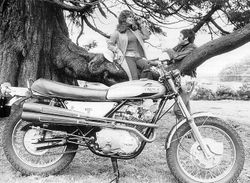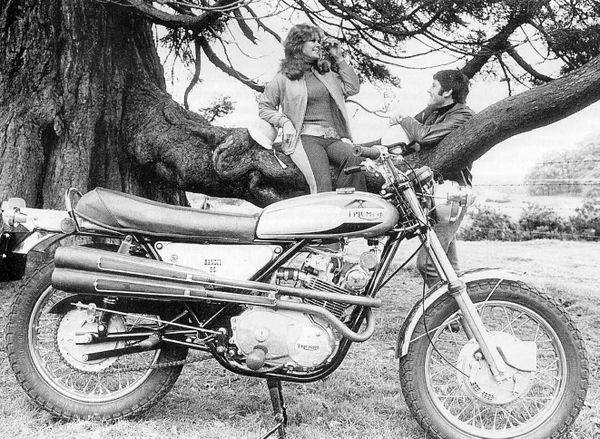Triumph Bandit 350SS
 |
|
| Triumph Bandit 350SS | |
| Manufacturer | |
|---|---|
| Production | 1971 |
| Engine | Four stroke, parallel twin, DOHC, 2 valvews per cylinder, alloy |
| Compression ratio | 9.5:1 |
| Top Speed | 160 km/h / 100 mph |
| Battery | 12V |
| Transmission | 5-Speed |
| Frame | Tubular steel, double cradle |
| Suspension | Front: Telescopic fork Rear: Twin shocks, coil springs |
| Brakes | Front: Drum, internal expanding Rear: Drum, internal expanding |
| Front Tire | 3.25 x 18 Dunlop K70 |
| Rear Tire | 3.50 x 18 Dunlop K70 |
| Wheelbase | 1489 mm / 58.6 in |
| Weight | 157 kg / 345 lbs (dry), 167 kg / 368 lbs (wet) |
| Fuel Capacity | 13.5 L / 3.6 US gal / 3.0 Imp gal |
| Manuals | Service Manual |
It could reach a top speed of 160 km/h / 100 mph.
Engine[edit | edit source]
The engine was a Air cooled cooled Four stroke, parallel twin, DOHC, 2 valvews per cylinder, alloy. The engine featured a 9.5:1 compression ratio.
Drive[edit | edit source]
Power was moderated via the Wet, multi-plate.
Chassis[edit | edit source]
It came with a 3.25 x 18 Dunlop K70 front tire and a 3.50 x 18 Dunlop K70 rear tire. Stopping was achieved via Drum, internal expanding in the front and a Drum, internal expanding in the rear. The front suspension was a Telescopic fork while the rear was equipped with a Twin shocks, coil springs. The Bandit 350SS was fitted with a 13.5 L / 3.6 US gal / 3.0 Imp gal fuel tank. The bike weighed just 157 kg / 345 lbs. The wheelbase was 1489 mm / 58.6 in long.
Photos[edit | edit source]
Overview[edit | edit source]
Triumph Bandit 350SS
Launched in 1971 the 5-speed, 349 cc (21.3 cu in) double overhead
cam twin cylinder Triumph Bandit delivered 34 bhp (25 kW) and could
reach 110 mph (180 km/h). Essentially the same motorcycle as the BSA
Fury, the Bandit represented the factory's last attempt to compete
against Japanese imports.
The only contemporary road test was by American magazine Cycle Guide in their March 1971 issue upon a visit to the Triumph and BSA factories at Meriden and Small Heath, respectively. The Bandit's petrol tank color scheme was Cypress Green (although Cycle World identified it as Jealous Green with white-lined black scallops above and below a metal Triumph badge with a chrome styling strip running down the top of the tank. The same paint scheme applied to the mudguards with a white-lined black stripe running down through their centre. The side panels were silver painted with black 'tombstone' style lettering stating the model name and engine size: 'Bandit 350'.
The engine was all-alloy as opposed to Triumph's other twins that relied upon an iron barrel and considered by Cycle Guide to be 'beautifully finished' and 'a real thing of beauty'. Cycle Guide criticised the retention of a traditionally Triumph vertically split crankcase halves rather than adopting the Japanese practice of horizontally splitting them. Despite this, it was noted that the engine was oil tight. The small diameter instruments and foot pegs thought mounted too far forward came in for criticism as did the poor conical hub rear brake performance, unlike the 'great' front brake. Lever travel between gears was felt to be too long although the clutch operation was 'silky smooth'.
The electrical system was twin coil and 12 volt and an electric starter was offered as an option. Carburetion was by two Amal 27mm carburetors. Cycle Guide were disappointed that the engine could not be expanded beyond 350cc but praised the engine's and exhausts' quietness. Two exhaust systems, a low level ('T35R') and high level (the 'T35SS' Street Scrambler version), were offered, the former offering more top speed. The low level exhaust system was finished in bright chrome, the high level system in matt black with a stainless steel heat shield. The T35SS version also came with what the brochure described as 'detachable electrics'. Tyres for both versions were the same, Dunlop K70; 3.25 x 18 inches for the front and 3.50 x 18 inches for the rear. Compression ratio was also the same for both : 9.5:1.
Overall, the review was extremely positive concluding, the Bandit 'will run at 90 mph (140 km/h) all day long' and Triumph would 'sell all they can crank out in the next 12 months' being 'a lot of machine for the money' (US$900). In the United Kingdom, a retail price of £402 was cited, some £83 less than Triumph's 500 cc (31 cu in) Daytona model and £91 more than their 250 cc (15 cu in) Blazer model.
| Make Model | Triumph Bandit 350SS (T35SS) |
|---|---|
| Year | 1971 |
| Engine Type | Four stroke, parallel twin, DOHC, 2 valvews per cylinder, alloy |
| Displacement | 349 cc / 21.3 cu in |
| Bore X Stroke | 63 x 56 mm |
| Cooling System | Air cooled |
| Compression | 9.5:1 |
| Engine Oil | 2.7 L / 5.7 US pt / 4.8 Imp pt |
| Exhaust | Two into two, high level |
| Induction | 2 x 27 mm Amal carburetors |
| Starting | Kick (electric starter option) |
| Battery | 12V |
| Max Power | 25 kW / 34 hp @ 9000 rpm |
| Max Torque | 28.4 Nm / 2.9 kgf-m / 21 lb-ft @ 7000 rpm |
| Clutch | Wet, multi-plate |
| Transmission | 5-Speed |
| Final Drive | Chain |
| Frame | Tubular steel, double cradle |
| Front Suspension | Telescopic fork |
| Rear Suspension | Twin shocks, coil springs |
| Front Brakes | Drum, internal expanding |
| Rear Brakes | Drum, internal expanding |
| Front Tire | 3.25 x 18 Dunlop K70 |
| Rear Tire | 3.50 x 18 Dunlop K70 |
| Wheelbase | 1489 mm / 58.6 in |
| Dry Weight | 157 kg / 345 lbs |
| Wet Weight | 167 kg / 368 lbs |
| Fuel Capacity | 13.5 L / 3.6 US gal / 3.0 Imp gal |
| Top Speed | 160 km/h / 100 mph |
